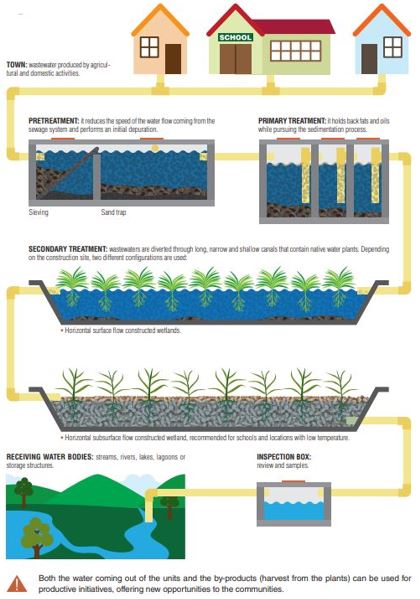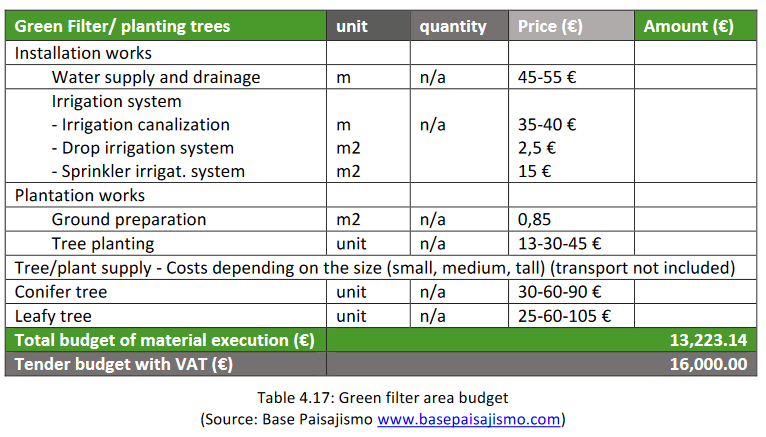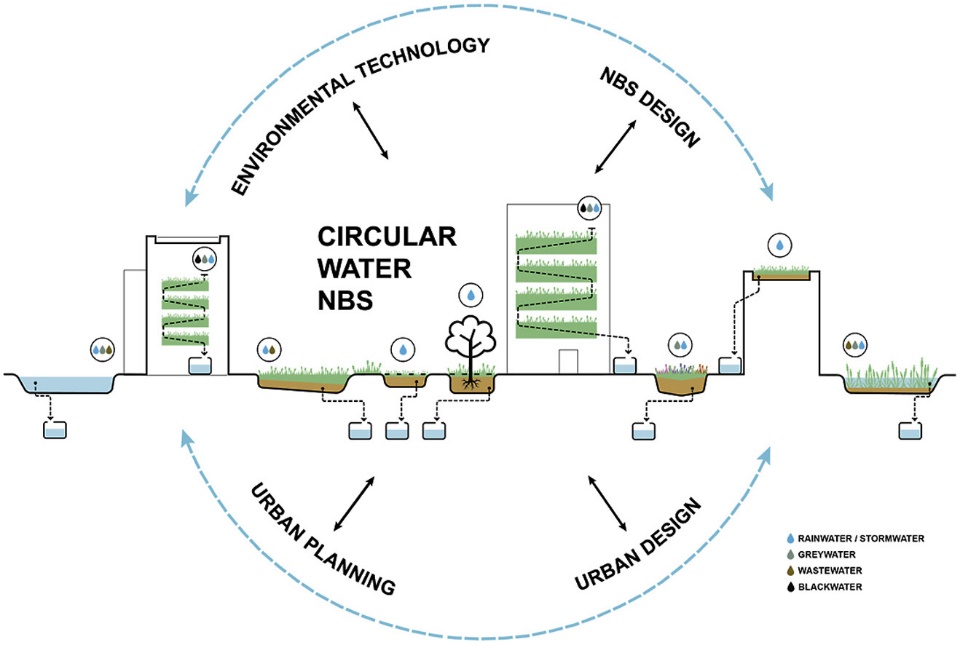Green filter areas are land application system, constructed to provide a buffer or pollution filter between industrial operations, roads, public spaces or walkways. Different typologies of vegetation have different performances and can be combined with solid barriers.

Green Filter area in Colombia
A specific application of green filter is used for treating water (wastewater). It consists of a plot area, sized according to the influent to be treated, which has forests installed and is irrigated with wastewater. The residual water partially evaporates and the rest is taken up by the roots of trees and filtered through the soil. Before application to the soil, it is desirable to introduce a primary treatment system, to remove coarse solids, sand, grease and solids. However, these systems provide more than just simple purification, because while treating the water, we are also producing biomass with high economic value.

Land Application Systems are considered a reliable, robust and low maintenance technology. This, together with the moderate cost of implementation, makes Land Application Systems a very competitive technology for treating wastewater from small towns or isolated areas.
The production of biomass, either high quality (cycles greater than 10 years) or intensively (cutting cycles 2 to 3 years), generates a by-product of commercial value that reduces the final running and maintenance costs.
Additionally, the added value generated by the capture of CO2 in the biomass growth processes may constitute an input to be considered in the case of larger installations. Recharging with the treated surplus is another big advantage, which can enable reuse in periods of great demand. Finally, the environmental impact caused by this type of treatment is minimal, and in some cases positive, as it generates a forest ecosystem of great natural and scenic value.
Therefore, the main co-benefits of this solutions are: reduce risk to natural and climate hazards, carbon sequestration, boost local business, increase technological readiness, raised awareness/behavioural change, better water quality and better water management, improve air quality, reduce hotspots and urban Heat Island Effect, species increase and reduce ecological footprint.
This solution is very much related with other circular economy solutions, such as grey water treatment or rain water management.
Climate and Geography:
This NBS is useful as a pre-treatment for returning water from sewage treatment plants back to the natural watercourse or as a wastewater treatment plant for small municipalities. Therefore, it can be adapted to any climate and geography.
The residual water partially evaporates and the rest is taken up by the roots of trees and filtered through the soil.
Urban Form and layout:
Green filter is a land application system for treating water (wastewater). It consists of a plot area, sized according to the influent to be treated, which has gardens and urban forests installed and is irrigated with wastewater. It has a moderate cost of implementation and has a very competitive technology for treating wastewater from small towns or isolated areas because this circular water system could be implemented at different scales ((micro/neighbourhood or building scale, meso/district scale) contributing to the recovery of water, energy, nutrients, energy, and other valuable resources.
Technical aspects/infrastructure:
Before application to the soil, it is desirable to introduce a primary treatment system, to remove coarse solids, sand, grease and solids. However, these systems provide more than just simple purification, because while treating the water, we are also producing biomass with high economic value.
Policy and regulatory/legal framework:
Treated water often has a bad odour and sometimes residues that can attract pests.
Therefore, all ordinances for the correct circulation, treatment and use must be complied with. Above all, environmental damage must be avoided.
Funding and financing, Economic and social context, Project governance and implementation modalities:
The Green Filter gets the recovery of the investment between the 10 and the 20 years.
As an NBS, expenditure can be charged to the municipality's Green Zones budget, as well as subsidies for water treatment, among other sources of funding.
On a social level it will have a great impact as it promotes ecological awareness, circular economy, as well as the improvement of the environment and the economic revaluation of the area.
In the case of the URBAN GreenUP project, Connection to the city sewage to conduct water didn’t guarantee a constant volume to the sustainable natural park, although this NBS shows certain robustness against fluctuations (in hydraulic load).
Also, urban environments make the soils impermeable so rainwater does not infiltrate the soil forming urban runoff which drains into the drainage network causing environmental degradation.
Moreover, there is no specific regulations, so political decisions should require.
On the other hand, a small seasonal river is near to the implementation so It has restrictive reuse of water and other regulations, overall high visual impact.
- Green Filter area (URBAN GreenUP project)
Climate mitigation & Adaptation
Trees and plants of waste water plant are sequestering carbon and contributing to reduce the effects of climate change and through increasing the urban vegetated urban area also may help to reduce the heat island effect, especially when trees are planted.
Water Management
The green filter is designed to treat wastewater before its discharge into the environment (soil). It the latest stage of a treatment train, therefore the water quality is expected to meet the regulations related to wastewater treatment/ reuse.
The expected removal rates of the green filter are similar to the ones reported for other natural technologies such as constructed wetlands (90-95% for suspended solids; 85-90% for BOD5; 80-90% for COD; 20-30 Ntotal; 20-30 Ptotal (Ortega, Ferrer, Salas, Aragón, & Real, 2010)).
Green Space Management
the Green Filter means the creation of a green area but some limitations to access to citizens must be established in order to avoid the contact with the pathogens in the wastewaters.
Air Quality:
Tress existing in green filters contributes to absorb polluting substances and improve air quality.
Research results revealed that parks with various types of vegetation played an important role in ameliorating air quality in urban areas through the reduction of suspended particles (TSP), sulfur dioxide (SO2) and nitrogen dioxide (NO2) (Yin et al., 2011). Researchers have been conducted in order to assess and quantify the carbon storage and sequestration by urban trees (Davies et al., 2011). Carbon sequestration by trees can also be estimated in monetary values (Baró et al., 2014)
Urban Regeneration
By creating new urban green spaces, Green Filters may contribute some aesthetic benefit to the urban landscape and if they are designed properly, they may help to increase the economic value of the area.
According to several studies, houses with a view of green are 1-15% more valuable. Offices with green spaces nearby can be 10% more valuable (de Roo, 2011).
Potential of economic opportunities and green jobs
The Green Filter, such as any other wastewater treatment plant, demands operation & maintenance tasks which require skilled personnel (supervisor and operators). Depending on the size and complexity of the installation the periodicity of those tasks will vary.
Around 160 h/year of operator are required for O&M for a natural wastewater treatment plant (Ortega, Ferrer, Salas, Aragón, & Real, 2010). Therefore, the installation of this NBS will partially contribute to the generation of green jobs.
- Educational activities on NBS: https://netzerocities.app/resource-1518
- Supporting municipalities to monitor resource flows in line with impact targets and measurement processes: https://netzerocities.app/resource-1528
- Capacity building and engagement with municipalities to identify and co-create circular solutions and roadmaps: https://netzerocities.app/resource-1548
- Capacity building for city officials to understand urban metabolisms and circular solution opportunities: https://netzerocities.app/resource-1568
- Capacity building and training: https://netzerocities.app/resource-1578
- Educational/ Capacity building barriers identification: https://netzerocities.app/resource-1588
- Engagement, co-creation and co-design of NBS and Green Infrastructure plans and interventions: https://netzerocities.app/resource-1608
- City coaching in NBS: https://netzerocities.app/resource-1618
- Integrated climate plans for cities (i.e.: SECAPs): https://netzerocities.app/resource-1698
- City water resilience assessment: https://netzerocities.app/resource-1738
- Public procurement for innovative NBS and Green Infrastructure interventions: https://netzerocities.app/resource-588
- NBS and Green Infrastructure regulation and ordinances: https://netzerocities.app/resource-1813
- NBS and Green Infrastructure plans and strategy design and governance: https://netzerocities.app/resource-1823
- NBS and Green Infrastructure Mapping: https://netzerocities.app/resource-1863
Water provision
Water from the last pond of the NTWP (VAc13) will be pumped to the green filter area. The following table shows the specifications of the submersible pump.

Technical Specifications of the submersible pump
The pumping pattern (and volume of water deviated to the green filter) will depend on the water demand of the vegetation/trees planted in the area.
Irrigation system
Drip irrigation will be implemented in the green filter area to avoid the production of aerosol, and, consequently, the reduction of the risk of contact with the citizens.

Typical flow-sheet of a Green Filter or Land application system (Source: Instituto IMDEA)

Green filter area budget. Source: Base Paisajismo
Other sources:

Scheme of Circular water NBS
Alexandra Tsatsou, Niki Frantzeskaki, Simos Malamis, "Nature-based solutions for circular urban water systems: A scoping literature review and a proposal for urban design and planning", Journal of Cleaner Production, 2023, 136325, ISSN 0959-6526,https://doi.org/10.1016/j.jclepro.2023.136325.
Comments ()